
Stuart Roy
Naval Architect & Consultant
Fellow of the Royal Institution of Naval Architects
Chartered Engineer
Email: info@StuartRoy.co.uk
Naval Architect & Consultant
Fellow of the Royal Institution of Naval Architects
Chartered Engineer
Email: info@StuartRoy.co.uk
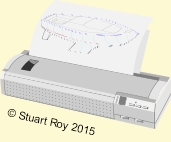

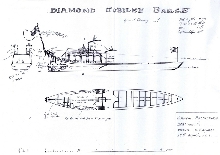
The Queen’s Rowbarge “Gloriana”
A magnificent traditionally-styled state barge
Mark Edwards’ first ideas for “Gloriana”
The shallop “Jubilant” built in 2002
Prince Frederick’s Barge, 1732
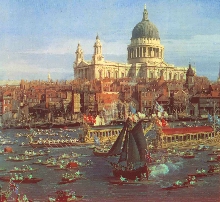
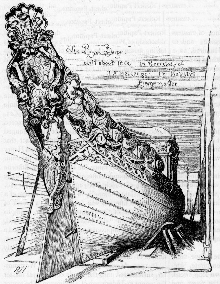
The English Royal Barge of 1600
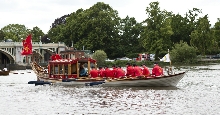
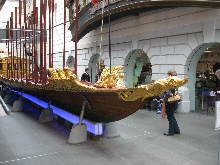
Ceremonial Barges in Canaletto’s time
This account, in five parts, tells how a team of 67 people including naval architects, engineers, shipwrights and craftsmen were brought together to create “Gloriana” - the boat that stole the show at the Diamond Jubilee Pageant on 3rd June 2012.
This is the Naval Architect’s story …..
Part 1: Historical References & Requirements
Although state barges have been in use in England since the 15th century or earlier it is likely that only a handful of naval architects in history have ever been commissioned to work on the design of a new Royal Rowbarge. It was therefore an immense honour and a very great privilege to be involved for 14 months in the project to design and build “Gloriana”, the boat that was to be a gift for Her Majesty the Queen in 2012, her Diamond Jubilee year.
In the past, water pageants were held on the River Thames to celebrate Royal occasions; one such event occurred at the time of King Charles ll’s marriage to Catherine of Braganza in August 1662. Pepys commented in his famous diary that there were 1000 barges afloat and that he could see no water between them. The last ornate barge intended for ceremonial use at state occasions by the British Royal Family and by civic dignitaries such as the Lord Mayor of London was designed by William Kent, built by John Hall and decorated by James Richards in 1732, some 280 years ago. This boat, which seems quite small today, still exists in the National Maritime Museum at Greenwich. It is known as Prince Frederick’s Barge, as it was commissioned by the Prince of Wales of the time, a man who is best known for his love of cricket, never becoming the King of England as he died before his father, King George II.
For me the Gloriana project started in just the same way as many other designs with a request for technical assistance on a new vessel. In early April 2011 I was contacted by master boat-builder Mark Edwards who had an idea for a new vessel and better still a potential client who might be persuaded to sponsor the project. Mark is an established builder and restorer of traditional wooden rowing boats based at the Bridge Boathouses beside the River Thames at Richmond, Surrey. In 2002 he had built “Jubilant”, a 45ft 8-oar wooden shallop, based on the 18th century Admiralty Commissioners’ barge that is now restored and on display near the old water gate at Somerset House in London. But his dream was to build a much larger wooden rowbarge in time for the river pageant being planned to celebrate Her Majesty the Queen’s Diamond Jubilee on 3rd June 2012. While Mark had the general idea for the boat in his mind, he needed a naval architect to investigate and develop the technical aspects to ensure that the boat would pass the current regulations and have satisfactory qualities of stability, speed and strength, thus safeguarding the client’s investment.
Mark’s enthusiasm and vision for the potential project was so infectious that I was immediately captivated and could not wait to get started. I therefore joined the project as its first employee with an initial brief to assess the feasibility of the proposed vessel and if possible develop the initial idea into a workable design proposal for a vessel capable of being rowed by 18 rowers while carrying 30 passengers and 4 crew - a total complement of 52 persons. This would mean a substantially larger vessel than Prince Frederick’s barge. Further, for both the Thames pageant itself and the planned legacy use afterwards the new rowbarge would need to be approved by the Maritime & Coastguard Agency (MCA) as a passenger vessel and be fully compliant with the current regulations for both intact and damage stability. It was apparent that only if the proposed design could be demonstrated in advance as being acceptable in principle to the MCA would the potential sponsor “come aboard” and make the funds available to start the build process. No pressure then!
The requirements for approval of UK-based passenger vessels are set out in an official 220-page Code of Practice published by the MCA and entitled MSN 1823 (M): Safety Code for Passenger Ships Operating Solely in UK Categorised Waters, with Category C waters being applicable to the tidal Thames. The regulations are very demanding and few, if any, large rowing vessels are able to comply, as all aspects of the construction, subdivision, stability, equipment and operation are subject to detailed guidelines. So the challenge in this project was actually to build a modern passenger vessel, compliant with the MCA Code, but still having the appearance of a traditional state rowbarge.
Soon after the initial enquiry I received Mark’s sketch for an 18-oar “Diamond Jubilee Barge” similar in style to the state and livery company barges of the 17th and 18th centuries, as depicted in the paintings of Canaletto, but with an ancestry that can be traced back much further to the Viking longships. I also had access to “Jubilant” and her plans, plus the added bonus that the last Royal Rowbarge still exists and is on public display at Greenwich. Prince Frederick’s 63ft Barge of 1732 was used as the official Royal Barge until 1849. Many of the city livery companies of the time also operated rowbarges for ceremonial use and these are well described in several sources. Better still, actual lines plans of several traditional rowbarges of the 18th century can be seen in the 1768 book “Architectura Navalis Mercatoria” by Swedish naval architect F H af Chapman.
This is the Naval Architect’s story …..
Part 1: Historical References & Requirements
Although state barges have been in use in England since the 15th century or earlier it is likely that only a handful of naval architects in history have ever been commissioned to work on the design of a new Royal Rowbarge. It was therefore an immense honour and a very great privilege to be involved for 14 months in the project to design and build “Gloriana”, the boat that was to be a gift for Her Majesty the Queen in 2012, her Diamond Jubilee year.
In the past, water pageants were held on the River Thames to celebrate Royal occasions; one such event occurred at the time of King Charles ll’s marriage to Catherine of Braganza in August 1662. Pepys commented in his famous diary that there were 1000 barges afloat and that he could see no water between them. The last ornate barge intended for ceremonial use at state occasions by the British Royal Family and by civic dignitaries such as the Lord Mayor of London was designed by William Kent, built by John Hall and decorated by James Richards in 1732, some 280 years ago. This boat, which seems quite small today, still exists in the National Maritime Museum at Greenwich. It is known as Prince Frederick’s Barge, as it was commissioned by the Prince of Wales of the time, a man who is best known for his love of cricket, never becoming the King of England as he died before his father, King George II.
For me the Gloriana project started in just the same way as many other designs with a request for technical assistance on a new vessel. In early April 2011 I was contacted by master boat-
Mark’s enthusiasm and vision for the potential project was so infectious that I was immediately captivated and could not wait to get started. I therefore joined the project as its first employee with an initial brief to assess the feasibility of the proposed vessel and if possible develop the initial idea into a workable design proposal for a vessel capable of being rowed by 18 rowers while carrying 30 passengers and 4 crew -
The requirements for approval of UK-
Soon after the initial enquiry I received Mark’s sketch for an 18-